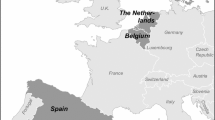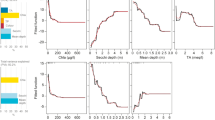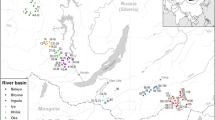Abstract
Macrophytes are an integral component of lake communities; therefore, understanding the factors that affect macrophyte community structure is important for conservation and management of lakes. In Sibley County, Minnesota, USA, five of the largest and most recreationally important lakes were surveyed using the point-intercept method. At each point the presence of macrophytes were recorded, water depth was measured, and a sediment sample was collected. Sediment samples were partitioned by determining sand, silt, clay, and organic matter fractions. The richness of macrophytes in all lakes were modeled via generalized linear regression with six explanatory variables: water depth, distance from shore, percent sand, percent silt, percent clay, and percent sediment organic matter. If model residuals were spatially autocorrelated, then a geographically weighted regression was used. Mean species richness (N point−1) was negatively related to depth and distance from shore and either positively or negatively related to silt depending on the lake and which macrophytes were present. All species richness models had pseudo-R2 values between 0.25 and 0.40. Curlyleaf pondweed (Potamogeton crispus) was found at 44% of all sampling points in one lake, and its presence was related to water depth, percent silt, and percent sediment organic matter during early season surveys. Results from this study exhibit the inhibitory relationship between water depth and macrophyte growth. The results from these models suggest interactions are complex between macrophytes, environmental factors, and sediment texture; and that these interactions are species and site specific. A single landscape scale model would not be appropriate to capture the in-lake processes driving macrophyte distribution and abundance; and management strategies will need to be developed on a lake-by-lake basis.






Similar content being viewed by others
Data availability
Data that support the findings of this study are available from the corresponding author, upon reasonable request.
Code availability
Not applicable.
References
Andersson B (2001) Macrophyte development and habitat characteristics in Sweden’s large lakes. Ambi 30:503–513. https://doi.org/10.1579/0044-7447-30.8.503
Azzella MM, Bolpagni R, Oggioni A (2014) A preliminary evaluation of lake morphometric traits influence on the maximum growing depth of macrophytes. J Limnol. https://doi.org/10.4081/jlimnol.2014.932
Bakker ES, Van Donk E, Declerck SAJ et al (2010) Effect of macrophyte community composition and nutrient enrichment on plant biomass and algal blooms. BAAE 11:432–439. https://doi.org/10.1016/j.baae.2010.06.005
Barko JW, Smart RM (1986) Sediment-related mechanisms of growth limitation in submersed macrophytes. Ecology 67:1328–1340. https://doi.org/10.2307/1938689
Barko JW, Adams MS, Clesceri NL (1986) Environmental factors and their consideration in the management of submersed aquatic vegetation: a review. J Aquat Plant Manag 24:1–10
Barko JW, Gunnison D, Carpenter SR (1991) Sediment dynamics with submersed macrophyte growth and community dynamics. Aquat Bot 41:41–65
Bini L, Thomaz S, Murphy K, Camargo A (1999) Aquatic macrophyte distribution in relation to water and sediment conditions in the Itaipu Reservoir, Brazil. Hydrobiologia 415:147–154. https://doi.org/10.1023/A:1003856629837
Blindow I (1992) Decline of charophytes during eutrophication: comparison with angiosperms. Freshw Biol 28:9–14. https://doi.org/10.1111/j.1365-2427.1992.tb00557.x
Bornette G, Puijalon S (2011) Response of aquatic plants to abiotic factors: a review. Aquat Sci 73:1–14. https://doi.org/10.1007/s00027-010-0162-7
Bouyoucos GJ (1962) Hydrometer method improved for making particle size analysis of soils. Agron J 54:464–465
Case ML, Madsen JD (2004) Factors limiting the growth of Stuckenia pectinata (sago pondweed) in Heron Lake, Minnesota. J Freshw Ecol 19:17–23
Chambers PA, Kaiff J (1985) Depth distribution and biomass of submersed aquatic macrophyte communities in relation to secchi depth. Can J Fish Aquat Sci. https://doi.org/10.1139/f85-090
Chen Y (2016) Spatial autocorrelation approaches to testing residuals from least squares regression. PLoS ONE 11:e0146865. https://doi.org/10.1371/journal.pone.0146865
Cheruvelil KS, Soranno PA (2008) Relationships between lake macrophyte cover and lake and landscape features. Aquat Bot 88:219–227. https://doi.org/10.1016/j.aquabot.2007.10.005
Cox MC, Wersal RM, Madsen JD et al (2014) Assessing the aquatic plant community within the Ross Barnett Reservoir, Mississippi. Invasive Plant Sci Manag 7:375–383. https://doi.org/10.1614/IPSM-D-13-00044.1
Dean WE (1974) Determination of carbonate and organic matter in calcareous sediments and sedimentary rocks by loss on ignition; comparison with other methods. J Sediment Res 44:242–248. https://doi.org/10.1306/74D729D2-2B21-11D7-8648000102C1865D
Dibble ED, Pelicice FM (2010) Influence of aquatic plant-specific habitat on an assemblage of small neotropical floodplain fishes. Ecol Freshw Fish 19:381–389. https://doi.org/10.1111/j.1600-0633.2010.00420.x
Downing JA, Prairie YT, Cole JJ et al (2006) The global abundance and size distribution of lakes, ponds, and impoundments. Limnol Oceanogr 51:2388–2397. https://doi.org/10.4319/lo.2006.51.5.2388
Fleming JP, Wersal RM, Madsen JD, Dibble ED (2021) Weak non-linear influences of biotic and abiotic factors on invasive macrophyte occurrence. Aquat Invasions 16:349–364
Gascoigne WR, Hoag D, Koontz L et al (2011) Valuing ecosystem and economic services across land-use scenarios in the Prairie Pothole Region of the Dakotas, USA. Ecol Econ 70:1715–1725. https://doi.org/10.1016/j.ecolecon.2011.04.010
Gerbersdorf SU, Jancke T, Westrich B (2007) Sediment properties for assessing the erosion risk of contaminated riverine sites. An approach to evaluate sediment properties and their covariance patterns over depth in relation to erosion resistance. First investigations in natural sediments. J Soils Sediments 7:25–35. https://doi.org/10.1065/jss2006.11.190
Guntenspergen G, Peterson S, Leibowitz S, Cowardin L (2002) Indicators of wetland condition for the Prairie Pothole Region of the United States. Environmental monitoring and assessment. Int J Devoted Prog Use Monit Data Assess Environ Risks Man Environ 78:229–252. https://doi.org/10.1023/A:1019982818231
Hechmi S, Hamdi H, Mokni-Tlili S et al (2020) Carbon mineralization, biological indicators, and phytotoxicity to assess the impact of urban sewage sludge on two light-textured soils in a microcosm. J Environ Qual 49:460–471. https://doi.org/10.1002/jeq2.20011
Heiri O, Lotter A, Lemcke G (2001) Loss on ignition as a method for estimating organic and carbonate content in sediments: reproducibility and comparability of results. J Paleolimnol 25:101–110. https://doi.org/10.1023/A:1008119611481
James WF, Best EP, Barko JW (2004) Sediment resuspension and light attenuation in Peoria Lake: can macrophytes improve water quality in this shallow system? Hydrobiologia 515:193–201. https://doi.org/10.1023/B:HYDR.0000027328.00153.b2
Johnston CA, McIntyre NE (2019) Effects of cropland encroachment on prairie pothole wetlands: numbers, density, size, shape, and structural connectivity. Landsc Ecol 34:827–841. https://doi.org/10.1007/s10980-019-00806-x
Kantrud HA (1990) Sago pondweed (Potamogeton pectinatus L.): a literature review. Washington, DC
Koch EW (2001) Beyond light: physical, geological, and geochemical parameters as possible submersed aquatic vegetation habitat requirements. Estuaries 24:1–17. https://doi.org/10.2307/1352808
Körner S, Nicklisch A (2002) Allelopathic growth inhibition of selected phytoplankton species by submerged macrophytes. J Phycol 38:862–871. https://doi.org/10.1046/j.1529-8817.2002.t01-1-02001.x
Lacoul P, Freedman B (2006) Environmental influences on aquatic plants in freshwater ecosystems. Environ Rev. https://doi.org/10.1139/a06-001
Liu L, Bu X-Q, Wan J-Y et al (2017) Impacts of sediment type on the performance and composition of submerged macrophyte communities. Aquat Ecol 51:167–176. https://doi.org/10.1007/s10452-016-9607-y
Madsen JD, Bloomfield JA, Sutherland JW et al (1996) The aquatic macrophyte community of Onondaga Lake: field survey and plant growth bioassays of lake sediments. Lake Reserv Manag 12:73–79
Madsen JD, Chambers PA, James WF et al (2001) The interaction between water movement, sediment dynamics and submersed macrophytes. Hydrobiologia 444:71–84. https://doi.org/10.1023/A:1017520800568
Madsen JD, Wersal RM, Tyler M, Gerard PD (2006) The distribution and abundance of aquatic macrophytes in Swan Lake and Middle Lake, Minnesota. J Freshw Ecol 21:421–429
Madsen J, Stewart R, Getsinger K et al (2008) Aquatic plant communities in Waneta Lake and Lamoka Lake, New York. Northeast Nat 15:97–110. https://doi.org/10.1656/1092-6194(2008)15[97:APCIWL]2.0.CO;2
Madsen JD, Wersal RM, Woolf TE (2015) Operational control of Eurasian watermilfoil (Myriophyllum spicatum) and impacts to the native submersed aquatic macrophyte community in Lake Pend Oreille, Idaho. Invasive Plant Sci Manag 8:219–232. https://doi.org/10.1614/IPSM-D-14-00008.1
National Resource Conservation Service (1997) Soil survey of Sibley County, Minnesota. United States Department of Agriculture
National Resource Conservation Service (2008) Lester series
National Resource Conservation Service (2015) Canisteo series
Naugle DE, Johnson RR, Estey ME, Higgins KF (2001) A landscape approach to conserving wetland bird habitat in the prairie pothole region of eastern South Dakota. Wetlands 21:1–17. https://doi.org/10.1672/0277-5212(2001)021[0001:ALATCW]2.0.CO;2
O’Hare MT, Baattrup-Pedersen A, Baumgarte I, et al (2018) Responses of aquatic plants to eutrophication in rivers: a revised conceptual model. Front Plant Sci 9
Radomski P, Perleberg D (2012) Application of a versatile aquatic macrophyte integrity index for Minnesota lakes. Ecol Ind 20:252–268. https://doi.org/10.1016/j.ecolind.2012.02.012
Reverey F, Grossart H-P, Premke K, Lischeid G (2016) Carbon and nutrient cycling in kettle hole sediments depending on hydrological dynamics: a review. Hydrobiologia 775:1–20. https://doi.org/10.1007/s10750-016-2715-9
Rivera-Monroy VH, Elliton C, Narra S et al (2019) Wetland Biomass and productivity in coastal Louisiana: base line data (1976–2015) and knowledge gaps for the development of spatially explicit models for ecosystem restoration and rehabilitation initiatives. Water 11:2054. https://doi.org/10.3390/w11102054
Rooney N, Kalff J (2000) Inter-annual variation in submerged macrophyte community biomass and distribution: the influence of temperature and lake morphometry. Aquat Bot 68:321–335. https://doi.org/10.1016/S0304-3770(00)00126-1
Salgado J, Sayer C, Carvalho L et al (2009) Assessing aquatic macrophyte community change through the integration of palaeolimnological and historical data at Loch Leven, Scotland. J Paleolimnol 43:191. https://doi.org/10.1007/s10933-009-9389-5
Salm CR, Saros JE, Fritz SC et al (2009) Phytoplankton productivity across prairie saline lakes of the Great Plains (USA): a step toward deciphering patterns through lake classification models. Can J Fish Aquat Sci 66:1435–1448
Schallenberg M, Burns CW (2004) Effects of sediment resuspension on phytoplankton production: teasing apart the influences of light, nutrients and algal entrainment. Freshw Biol 49:143–159. https://doi.org/10.1046/j.1365-2426.2003.01172.x
Scheffer M (1999) The effect of aquatic vegetation on turbidity; how important are the filter feeders? Hydrobiologia 408(409):307–316
Scheffer M (2004) Ecology of shallow lakes. Kluwer, Dordrecht
Schmid SA, Wersal RM (2021) Aquatic macrophyte community shifts in five shallow lakes in Sibley County, MN. J Aquat Plant Manage 59:72–78
Sibley County (2018) Statistics—economic developement. In: Sibley County, MN. https://www.co.sibley.mn.us/economic_development/visitors/about_us/statistics/index.php
Silveira MJ, Thomaz SM (2015) Growth of a native versus an invasive submerged aquatic macrophyte differs in relation to mud and organic matter concentrations in sediment. Aquat Bot 124:85–91. https://doi.org/10.1016/j.aquabot.2015.03.004
Takamura N, Kadono Y, Fukushima M et al (2003) Effects of aquatic macrophytes on water quality and phytoplankton communities in shallow lakes. Ecol Res 18:381–395. https://doi.org/10.1046/j.1440-1703.2003.00563.x
van Gerven LPA, de Klein JJM, Gerla DJ et al (2015) Competition for light and nutrients in layered communities of aquatic plants. Am Nat 186:72–83. https://doi.org/10.1086/681620
Wang C, Zheng S, Wang P, Hou J (2015) Interactions between vegetation, water flow and sediment transport: a review. J Hydrodyn 27:24–37. https://doi.org/10.1016/S1001-6058(15)60453-X
Waters NM, Giovanni CRS (2002) Distribution and diversity of benthic macroinvertebrates associated with aquatic macrophytes. J Freshw Ecol 17:223–232. https://doi.org/10.1080/02705060.2002.9663890
Wersal RM, McMillan BR, Madsen JD (2005) Food habits of dabbling ducks during fall migration in a prairie pothole system, Heron Lake, Minnesota. Can Field Nat 119:546–550. https://doi.org/10.22621/cfn.v119i4.186
Wersal R, Madsen J, McMillan B, Gerard P (2006) Environmental factors affecting biomass and distribution of Stuckenia pectinata in the Heron Lake System, Minnesota, USA. Wetlands 26:313–321. https://doi.org/10.1672/0277-5212(2006)26[313:EFABAD]2.0.CO;2
Wersal RM, Madsen JD, Cheshier JC (2010) Aquatic plant monitoring in Noxon Rapids Reservoir and Cabinet Gorge Reservoir for 2010. Geosystems Research Institute
Wetzel RG (2001) Limnology. Academic Press, San Diego
Woolf TE, Madsen JD (2003) Seasonal biomass and carbohydrate allocation patterns in southern Minnesota curlyleaf pondweed populations. J Aquat Plant Manag 41:113–118
Wright CK, Wimberly MC (2013) Recent land use change in the Western Corn Belt threatens grasslands and wetlands. Proc Natl Acad Sci 110:4134–4139. https://doi.org/10.1073/pnas.1215404110
Wu D, Hua Z (2014) The effect of vegetation on sediment resuspension and phosphorus release under hydrodynamic disturbance in shallow lakes. Ecol Eng 69:55–62. https://doi.org/10.1016/j.ecoleng.2014.03.059
Zhu M, Zhu G, Nurminen L et al (2015) The influence of macrophytes on sediment resuspension and the effect of associated nutrients in a shallow and large lake (Lake Taihu, China). PLoS ONE 10:e0127915. https://doi.org/10.1371/journal.pone.0127915
Acknowledgements
Thanks to the Sibley County Soil and Water Conservation District for funding this study. Thanks to Joel Wurscher and Jack Bushman from Sibley County Soil and Water Conservation for logistic and informational contributions to this study. Thanks to the following Aquatic Weed Science Lab Technicians: Alex Green, Amber Fistler, Ashley Kasper, BaileyClaire Scott, Franklin Rogers, June Somsanith, Kari Solfest, Sara Ademi, and Vincent McKnight.
Funding
This research was funded by the Sibley County Soil and Water Conservation District through funds allocated from the Aquatic Invasive Species Prevention Aid program.
Author information
Authors and Affiliations
Contributions
SS – conducted the research as part of his MS degree, analyzed data, and was the primary writer of the manuscript. RW – was the chair of the graduate committee, assisted in field data collection, and was a major contributor in data analysis and manuscript preparation. JF – was a major contributor in spatial model creation and data analysis, he was also a major contributor in manuscript preparation.
Corresponding author
Ethics declarations
Conflict of interest
There are no conflict of interests.
Ethics approval
Not applicable.
Consent to participate
Not applicable.
Consent for publication
The authors consent to have this manuscript published if accepted.
Additional information
Handling Editor: Asaeda Takashi.
Publisher's Note
Springer Nature remains neutral with regard to jurisdictional claims in published maps and institutional affiliations.
Rights and permissions
About this article
Cite this article
Schmid, S.A., Wersal, R.M. & Fleming, J.P. Abiotic factors that affect the distribution of aquatic macrophytes in shallow north temperate Minnesota lakes: a spatial modeling approach. Aquat Ecol 56, 917–935 (2022). https://doi.org/10.1007/s10452-022-09969-3
Received:
Accepted:
Published:
Issue Date:
DOI: https://doi.org/10.1007/s10452-022-09969-3




